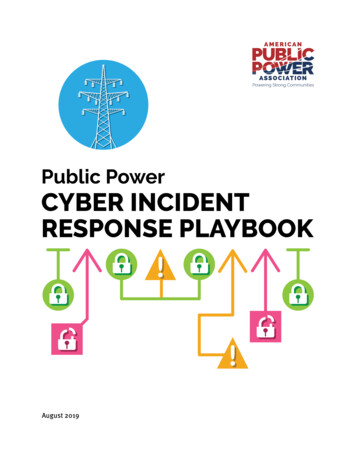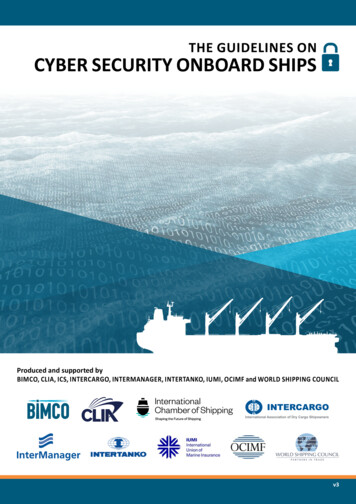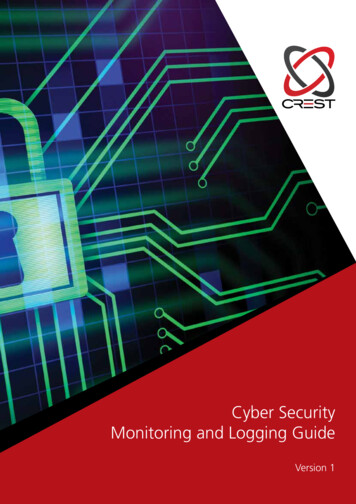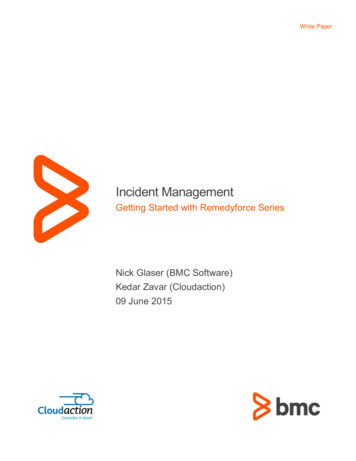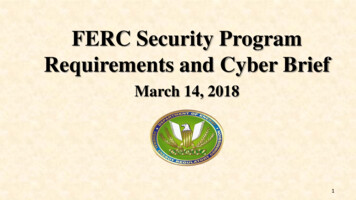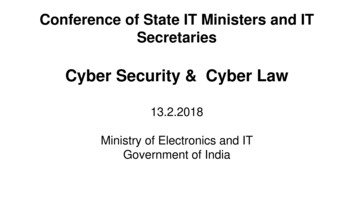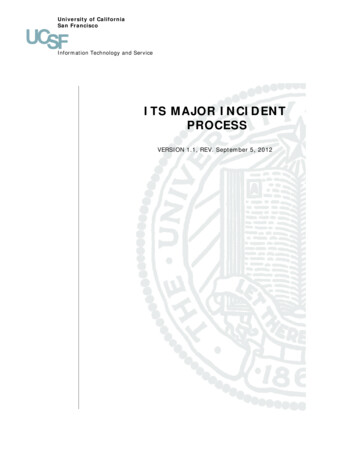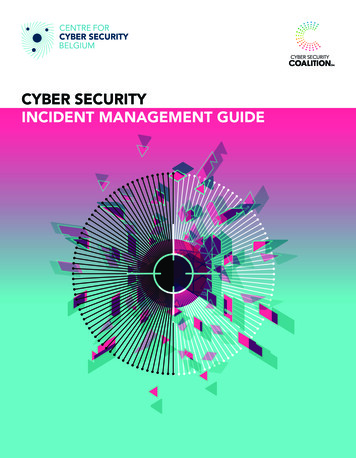
Transcription
CYBER SECURITYINCIDENT MANAGEMENT GUIDE
ABOUTThe Cyber Security Coalition is a unique partnershipbetween players from the academic world, the public authorities and the private sector who have joinedforces in the fight against cybercrime. Currently morethan 100 key players from across these 3 sectors areactive members contributing to the Coalition’s mission and objectives.The Coalition responds to the urgent need for across-sector collaboration to share knowledge andexperience, to initiate, organise and coordinate concrete cross-sector initiatives, to raise awarenessamong citizens and organisations, to promote thedevelopment of expertise, and to issue recommendations for more efficient policies and regulations.The objective of this guide is to raise awarenesswithin companies of all sizes about the importanceof planning the management of cyber security incidents ahead of time.This Guide and the accompanying documents have been produced by the CyberSecurity Coalition.All texts, layouts, designs and elements of any kind in this Guide are protected bycopyright.Extracts from the text of this Guide may be reproduced for non- commercial purposesonly, provided that the source is specified. The Cyber Security Coalition disclaims anyliability for the content of this Guide.The information provided: Is exclusively of a general nature and not geared towards the specific situation of anyindividual or legal entity Is not necessarily complete, accurate or up to date Does not constitute professional or legal advice Does not replace expert advice Does not provide any warranty for secure protection.
EXECUTIVE SUMMARY3EXECUTIVESUMMARYThis Guide aims to draw attention to the importance of planning how to manage a cyber security incident ahead of time.Cyber security incident management is not a linear process; it’s a cycle thatconsists of preparation, detection, incident containment, mitigation andrecovery. The final phase consists of drawing lessons from the incident inorder to improve the process and prepare for future incidents. During thiscycle, communication with both internal and external stakeholders is of critical importance.Many organisations may not have the necessary in-house expertise and skillsto respond adequately to a cyber security incident. When they are facing anincident, they may need to call upon experts to contain the incident and/orto carry out forensic investigations. This does not mean that they cannot doanything themselves. On the contrary, there are a lot of things that can andshould be done before an actual incident occurs.Drawing up an organisation’s cyber security incident response plan is animportant first step in cyber security incident management. It is also crucialthat top management validates this plan and is involved in every step of thecyber security incident management cycle.The following elements should be included in the cyber security incident response plan: What needs to be protected? Which information, systems, network, products, ?; Identification and assignment of responsibilities; In-house capabilities or contracts with external experts for incident response and/or forensic investigation; The equipment and technology; A basic containment strategy: disconnect the systems immediately in orderto recover as quickly as possible? Or take the time to collect evidence? A communication strategy for both internal and external stakeholders andfor authorities such as law enforcement, the National Data Protection Authority and the competent authorities for reporting Network and Information Security (NIS) incidents.Operators of essential services (OES) and digital service providers (DSP), asdescribed in the Belgian Network and Information Security Act of 7 April2019, are subject to specific obligations concerning the security of their information systems and the defence against and reporting of incidents. Theinformation in this Guide may assist in taking the right measures to complywith the latter.Finally, organisations should consider taking out a cyber insurance policy. Thecost of cyber security incidents often amounts to hundreds of thousands oreven millions of euros. A reliable cyber insurance policy will cover at least partof this cost.
CONTENTS0102030405EXECUTIVE SUMMARY3FOREWORD5BASIC PRINCIPLES & KEY DEFINITIONS6PREPARING FOR A CYBER SECURITY INCIDENT8I.II.III.IV.V.VI.VII.Draft a cyber security incident response plan and keep it up to dateContent of a cyber security incident response planAssigning responsibilities and creating a cyber security incident response teamCall upon external expertsEquip your organisation to address a cyber security incidentPrepare your communication strategyCyber insuranceDETECTING AND IDENTIFYING POTENTIAL CYBER SECURITY INCIDENTS20I. Categories of incidentsII. Methods for detecting incidentsHANDLING AN ACTUAL INCIDENT: CONTAIN, ERADICATE AND RECOVERI.II.III.IV.V.22Convene your cyber security incident response teamSituational awarenessContaining a cyber security incidentEradication and clean-upRecoveryCOMMUNICATION DURING A CYBER SECURITY INCIDENT29I. ToolsII. Incident-specific communication planINCIDENT FOLLOW-UP AND CLOSURE:LEARN FROM EACH INCIDENT!36I. Evaluation of lessons learned and future actions: organise a post-incident reviewII. Incident tracking and ANNEX42
5FOREWORDFOREWORDThe Internet is revolutionising the way we do business: the amount of datathat we transfer over the Internet and our dependency on it being availablekeeps on increasing. It is crystal clear that connecting to the world not onlybrings great opportunities but also generates new risks. Cybercrime is bigbusiness and even the smallest malicious attack can seriously damage anorganisation’s reputation, productivity, ICT system, etc.No organisation should think it is safe from cybercrime. Cybercriminals do notjust target large organisations. On the contrary, a small organisation may bea more interesting victim because of the information it processes or even thepartners it works with.There are only two typesof companies: those thathave been hacked andthose that will be.Robert MuellerThis Guide draws attention to the importance of knowing that one day or another your organisation could be the target of a cyber attack. And when thathappens, you need to be prepared! A good cyber security incident responseplan can make the difference between a cyber security incident and a cybersecurity crisis. The pace at which an organisation is able to recognise, analyseand respond to an incident will influence the damage done and the cost ofrecovery.Such a cyber security incident response plan should not be limited to technology! Processes, people and other organisational aspects are also importantelements to take into consideration.Reading this Guide will not make you an instant expert in cyber security incident management. Why not? Because it takes time and experience to buildup the necessary expertise to be able to efficiently handle cyber securityincidents. So, bear in mind that it often involves a growth process of trial anderror.Jan De BlauweChairman of the CyberSecurity CoalitionMiguel De BruyckerManaging Director Centre forCyber Security Belgium (CCB)
6BASIC PRINCIPLES & KEY DEFINITIONSBASIC PRINCIPLESKEY DEFINITIONS&While reading this Cyber Security Incident ManagementGuide, you should keep the following basic principles and keydefinitions in mind.KEY DEFINITIONSAt the end of this Guide you willfind a complete glossary. Hereafterwe will highlight a number of definitions that are key to understandingthe scope and content of this Guide.CYBER SECURITY EVENTA cyber security change that mayhave an impact on organisationaloperations(including mission, capabilities, orreputation).CYBER SECURITY INCIDENTA single or a series ofunwanted or unexpected cyber security events that are likely to compromise organisational operations.CYBER SECURITY INCIDENTMANAGEMENTProcesses for preparing, detecting,reporting, assessing, respondingto, dealing with and learning fromcyber security incidents.1.2.3.There is no simple one-size-fits-all solutionAlways keep in mind that every organisation is different. When itcomes to Cyber Security there is no one-size-fits-all solution.What will work for your organisation will depend on its mission andgoals, the kind of infrastructure and information you are protecting,available resources, etc. Finally, recognise that some techniqueswill only be learned with time and experience. This should not,however, stop you from getting started!Top management’s commitmentCyber security incidents are a risk that should be incorporated inthe overall risk management policy of your organisation. Furthermore, managing cyber security incidents does not just mean applying technology. It also requires the development of a plan thatis integrated into the existing processes and organisational structures, so that it enables rather than hinders critical business functions. Therefore, top management should be actively involved indefining an organisation’s cyber security prevention and incidentresponse plan, because top management’s explicit support throughappropriate internal communication and the allocation of personnel and financial resources is key to the success of the plan.A well-informed top manager will be aware both of the risks ofcybercrime and of his/her own exemplary role in encouraging allmembers of the organisation to assume their responsibility.Involve every member of your organisationIt is often said that humans are the weakest link when it comes tocyber security. Having said that, it is also important to realise thatthe members of your organisation have great potential to help youdetect and identify cyber security incidents. Make sure that everymember of your organisation is aware of your cyber security incident response plan and of their own role within it, even if thisjust means informing the right person about the ICT anomalies theystumble upon.
BASIC PRINCIPLES & KEY DEFINITIONS4.5.6.7.8.9.7Keep an offline copy of the documents you needduring an incidentBear in mind that when a cyber security incident occurs, you may not always have access to the files on your computer. It is always a good idea to keep a hard copy/offlinecopy of any document you are likely to need during a cyber security incident or crisis.Don’t link backups to the rest of your systemWhen it comes to backups, not only is it crucial to have them, it’s also very important tohave a backup that is not linked in any way to the rest of your system. If your backup is linked to your system, chances are that the infection of your system also spreadsto your backup, which makes your backup useless.The importance of logging and keeping those logsfor a certain period of time (up to 6 months)Logs can help you to trace back the origin of the cyber security incident. This isnot only important to be able to identify the cybercriminal; it can also help your organisation to get back to business as soon as possible.Keep your cyber security response plan and all relatedinformation and documents up to date!Make sure you take all legal aspects into accountwhen managing a cyber security incidentEvidence will only be admissible in court if it has been collected in respect of all applicable laws and regulations. Furthermore, in some cases you have a duty to report tothe authorities or relevant people, e.g. the National Data Protection Authority or therelevant competent body for reporting Network and Information Security incidents.Document every step of a cyber security incidentIn times of crisis, don’t just rely on your head! Make sure you write down any action thatis taken, such as the reporting of the incident, the collecting of evidence, conversationswith users, system owners and others, etc. This documentation is your ‘time machine’.When something goes wrong it may allow you to look back and evaluate where andwhy the problem started. Furthermore, documenting the cyber security incident response will ensure that the knowledge regarding what is going on is not just in a fewpeople’s heads.
8PREPARING FOR A CYBER SECURITY INCIDENT01I.PREPARING FOR ACYBER SECURITY INCIDENTDRAFT A CYBER SECURITY INCIDENT RESPONSE PLANAND KEEP IT UP TO DATEWhen facing a cyber security incident, an organisation should be able to react in a prompt andappropriate manner. This is why it is important to decide how you will handle certain situationsahead of time instead of when you encounter them for the first time during an incident. Make aplan (on paper, not just in your head) to limit damage, to reduce costs and recovery time and tocommunicate with both internal and external stakeholders.REVIEW YOUR CYBER SECURITY INCIDENT RESPONSE PLANA cyber incident response plan is not a static document. It is important to integrate it into yourbusiness processes and to review and update it regularly, on a yearly basis and as part of thepost-incident review.CYBER SECURITY INCIDENT RESPONSE PROCEDURESBuilding on your cyber security incident response plan, you can define a number of standard operating procedures for common incidents that are likely to occur within your organisation. Such aprocedure should explain step by step how a specific issue can be tackled. These quick responseguides for likely scenarios should be easily accessible.KEY ELEMENTS OF A CYBER SECURITY INCIDENT RESPONSE PLANHOW TO ADDRESSTECHNICALPROTECTIONAND END POINTPROTECTION?COMPOSITIONAND ROLES OFYOUR INCIDENTRESPONSE TEAMWHAT DOES ACYBER INCIDENTMEAN FOR YOURORGANISATION?WHAT TOPROTECT?WHO HAS THE ULTIMATERESPONSIBILITY IN CASEOF A CYBER INCIDENT?IDENTIFYPOSSIBLECATEGORIESOF INCIDENTSWHEN WILL YOUINVOLVEEXTERNALEXPERTS?INTERNAL ANDEXTERNALCOMMUNICATIONIN CASE OF A CYBERINCIDENT
9PREPARING FOR A CYBER SECURITY INCIDENTII.CONTENT OF A CYBER SECURITYINCIDENT RESPONSE PLANKNOW WHAT TO PROTECTIdentify your assets andpotential threatsWhen hit by an incident, the first questions that will arise are: which assets areat risk and which of those assets are vitalfor your business activities? You will haveto decide which assets need your attention first in order to remain in businessand keep the damage to your business asminimal as possible.That’s why it is crucial to identify, document and categorise your organisation’s ‘vitals’: the assets your organisationdepends on to conduct its core activities.This will help you identify where to applywhich protective measures and to takequick and justified decisions during theincident management process.The following list gives you an idea ofwhat those ‘vitals’ could be: management,organisation, processes, knowledge (e.g.intellectual property has been stolen),people, information (e.g. data sets havebeen stolen or altered), applications (e.g.website is down or defaced, infrastructure(e.g. system and/ or network connectionsare down), financial capital (e.g. bank accounts).It’s also a good idea to identify vulnerabilities and potential STRUCTURE
PREPARING FOR A CYBER SECURITY INCIDENT2.10How to identify, document and categorise yourorganisation’s vitals, vulnerabilities and potential threatsA. Identify the business and the resources that need to be protected Determine which of your core business activities enable your organisation to exist andachieve its corporate objectives and generate income: produce goods, sell goods,deliver goods, etc. For each of those activities, identify which ICT systems (databases, applications, control systems) and network connections are supporting them Determine also where these ICT systems are located: on your own servers or in thecloud? When identifying these assets, don’t forget flows of information to third parties (suppliers, clients, etc.) or industrial control system flows.B. Identify your crown jewelsDetermine now which assets, data, processes or network connections are so importantfor your organisation that if you lose (control of) them, you are in big trouble or evenout of businessC. Assign business priorities for recoveryThis act of prioritising will determine the order in which the systems will be re-established. In most cases the underlying network will need the highest priority, as this is notonly the path by which your system administrators reach your assets but also the paththat cyber criminals use to attack your systems. As long as criminals can use your network connections, any other recovery activity might be undone by them. When assetsare equally high priority, parallel recovery activities might be considered.D. Document how your systems work and keep this documentationup to dateEnsure that the way your systems work is documented and that thisinformation is kept up to date and available on the incident response team’s documentation systems. Absolutely essential documents are:Network Scheme displaying the network architecture with internal network segmentation and the different gateways to external networks, DMZ, VPN, IP-address ranges used. This scheme should also include the different security devices in place thatmight contain logging information of network activity (firewalls, (reverse) proxy servers,intrusion detection systems, security incident event management systems). For largercompanies with complex networks, it is also necessary to have a high level version ofthe network architecture so that you can quickly get an idea of the network in case ofemergency.Make sure your systemsare not just a bunch ofcables and computersto you! It is crucial thatyour system managerknows how yournetwork works and isable to explain it toexperts, police, etc.Equipment and services inventory. This inventory will include, for the vital assets inyour environment, all the different servers and the network components used for delivering the different corporate services. As some of these (physical) servers might beservicing multiple business functions, it is important to know which services are runningon which server.Account and access lists. At all times it is important to know who has the right to access, use and/or manage your network and the different systems in it. This will allow youto detect any strange or abused accounts during an incident.
11PREPARING FOR A CYBER SECURITY INCIDENTIII.ASSIGNING RESPONSIBILITIES AND CREATINGA CYBER SECURITY INCIDENT RESPONSE TEAMASSIGNING RESPONSIBILITIES AND ROLES TO PEOPLE WITHTHE RIGHT SKILLSIt is important that the roles and responsibilities in case of a cyber security incident aredocumented in your cyber security incident response plan. When drafting the description of these roles and responsibilities, you should ask yourself the following questions:1. Who is the internal contact point for cyber security incidents? And how can he/shebe contacted?2. What are the different incident response tasks? And who is responsible for doingwhat?3. Who is managing the incident from the business/technical side? This should besomeone within your company with decision-making authority, who will follow theincident from start to finish.4. Who will liaise with senior management?5. Who can engage the external incident response partner?6. Who can file a complaint with law enforcement/inform the regulatory bodies?7. Who is entitled to communicate with the press and external parties?You will realise that in order to adequately address a cyber security incident, differentskills are needed to take on the different responsibilities and necessary roles in an efficient incident response.SKILLSRESPONSIBILITIESROLESIncident managementManaging the cyber security incident from the moment of its detection until its closure.Cyber security incidentresponse managerBusiness decision capabilityAssessing the business impact and acting upon it. Engaging the right resources. Takingdecisions on how to proceed, e.g. deciding if the internet connection of a compromisedsystem can be shut down and when is the most appropriate time. Deciding when tostart clean-up activities. Deciding whether to file a complaint.ManagementNetwork managementcapabilitiesTechnical know-how on the organisation’s network (firewall, proxies,IPS, routers, switches, ). Analysing, blocking or restricting the data flow in and out ofyour network. IT operations, information security and business continuity.ICT technical support staffWorkstation and serveradministrator capabilities (adminrights)Analysing and managing compromised workstations and servers.ICT technical support staffLegal adviceAssessing the contractual and judicial impact of an incident. Guaranteeing that incidentresponse activities stay within legal, regulatory and the organisation’s policy boundaries.Filing a complaint.Legal department/company lawyerCommunication skillsCommunicating appropriately to all relevant stakeholder groups. Answering customers,shareholders, press questions immediately.Communications or publicrelations departmentForensic skillsGathering and analysing evidence in an appropriate way, i.e. so that the evidence isadmissible in a court of law.ICT technical support staffPhysical securityHandling the aspects of the incident that are linked to the physical access to the premises the physical protection of the cyber infrastructure.Security OfficerCrisis managementCrisis managementCrisis manager
12PREPARING FOR A CYBER SECURITY INCIDENTCYBER INCIDENT RESPONSE TEAMIn an ideal world every organisation has an incident response team that is convened whenever there is an incident. Of course, the size of the company determines the size and structure of the incident response team. Smaller companies that do not have the resources foran actual team could designate a first responder – ideally someone with business decisioncapability – from among their personnel. In case of a cyber security incident, he/she shouldcontact external help but will remain the person ultimately responsible for the incident response within the organisation.The composition of this incident response team will be determined by the different skillsthat are needed to handle an incident (see also: table on page 11). For smaller companies,some of these skills may have to be sourced outside the organisation by the first responder.A MINIMAL INCIDENT RESPONSE TEAM SHOULD INCLUDE THE FOLLOWING ROLESINCIDENT RESPONSE MANAGERICT TECHNICAL SUPPORT STAFFThe person that will manage the incident as soonas it is brought to their attention until it has beencontained and remediated. He/she will liaise theinvestigation of the indicators, the with management,and possibly with other internal staff and with external resources to handle the incident. This personhas to have knowledge about your organisation’sbusiness activities because they will be the first totake business decisions.This person needs to have a goodknowledge of your ICT infrastructure asthey will be responsible for the investigation of the indicators, confirmation ofthe incident and developing the technical solutions to manage the incident.YOUR ORGANISATION’S SIZE AND NATURE WILL DETERMINEIF MORE ROLES ARE NECESSARYSmaller organisations often have the flexibility to quickly engage corporate managementin order to manage the incident. This is not the case for larger organisations that mighthave to handle several incidents in a more autonomous mode, in which case corporateexecutives will only be engaged in incident response actions when a very serious incidentoccurs.Larger organisations. The bigger your organisation, the more differentiated the composition of your incident response team will have to be. For larger organisations, in additionto the incident response team, a crisis management team composed of corporate management representatives might be set up to take over the responsibility for strategic andbusiness-related decisions and communications when confronted with serious incidents.This will enable the incident response manager to focus more on the technical issues ofthe incident.
13PREPARING FOR A CYBER SECURITY INCIDENTCERTAIN ORGANISATIONS MUST APPOINT A DATAPROTECTION OFFICER OR A CONTACT POINTThe General Data Protection Regulation (GDPR) obliges certain organisations to appoint a Data Protection Officer or ‘DPO’. More specifically those organisations involvedin processing personal data and that require regular and systematic observation on alarge-scale of those concerned, or are charged with large-scale processing of specialcategories of data, for example, health-care data, or criminal convictions or offences.The Network and Information Security (NIS) Directive requires operators of essentialservices (OES) and digital service providers (DSP) to appoint a contact point for thesecurity of network and information systems in order to allow seamless communicationwith the competent authorities in the case of incidents.IV.CALL UPON EXTERNAL EXPERTSEXPERTS ON CYBER INCIDENT RESPONSEWhether your organisation is an SME or a large organisation, it is costly to develop andmaintain all the necessary expertise and skills for incident response in house. This isespecially true for forensic and legal advisory cyber security incident response skills. Sobear in mind that it might be more cost-effective to call upon external cyber securityincident response partners to close the gap in your organisation’s skills base. Professional incident responders with their knowledge of possible threats and scenarios might reduce the time for diagnosing the incident. They take a forensically sound approach so that any evidence will be secured anddocumented according to a legally valid chain of custody. This evidence can then bepresented later in court if necessary. They have experience of doing things in the right order and have the tools for recovering traces from RAM memory, virtual machines, hard disks and networks. These experts will help you to identify the causes of the incident and will offer adviceon how to contain, eradicate and remediate the incident.WHEN TO CONTACT AN EXPERT?A.DURING THEPREPARATION PHASEVSB.WHEN A CYBERSECURITY INCIDENTOCCURS
PREPARING FOR A CYBER SECURITY INCIDENT14You can either contract and retain a cyber security incident response partner during thepreparation phase, or wait until an actual cyber security incident occurs. Bear in mindthat establishing such a contract takes time and effort. So if you are sure you will needexternal help, it might be better not to wait. This way you will win precious time atthe beginning of the cyber security incident. Several specialised consulting firms forincident response services and law offices offer subscriptions that keep their incidentresponse capabilities on retainer for the subscriber. Furthermore, most of these includetraining sessions with your incident response team to facilitate cooperation betweenthem when an incident occurs.CERTAIN AUTHORITIES MIGHT BE OF HELP TO YOURINVESTIGATIONOther parties like industry regulators, the National Data Protection Authority, the Centre for Cyber Security in Belgium (CCB), Cert.be department, and law enforcement(police and magistrates) might be of importance when you’re confronted with a cybersecurity incident of a criminal nature or in case of a personal data breach. Some legislation even obliges you to inform these parties when you have detected an incident ofa specific nature (see also: page 31, Reporting to authorities).These parties can often help with information on the threat and with practical guidelines based on previous incidents they have handled. Do bear in mind, though, thatthe objective of law enforcement is to identify and catch the attacker. It is not their taskto get your business up and running again. It is also possible that the most effectiveway to catch the attacker is not necessarily the same as the fastest way to get back tobusiness as usual.Furthermore, most of these investigations are covered by professional secrecy, whichmakes it rather difficult to obtain information about their results. They might, however,disclose information that will help you to identify the attacker and their modus operandi, which may speed up the analysis of your cyber security incident.The police might ask your organisation not to shut down your system rightaway. If you do, the attacker will notice and retreat, which often makes itimpossible to trace them afterwards. However, for your organisation thefastest way to get back to business might be to shut down immediatelyand start with a clean slate.
15PREPARING FOR A CYBER SECURITY INCIDENTV.EQUIP YOUR ORGANISATION TO ADDRESSA CYBER SECURITY INCIDENTYOUR NETWORK OF EXPERTS – MAKE A CONTACT LISTSeeking help from the right professionals at the right time is crucial during an incident,as it might help limit the physical and reputational damage to your company. A contactlist that includes all of these people or organisations will help you in this process. Thislist contains the names, roles, contact and backup details of the different members ofthe cyber incident response team, the external parties on retainer, law enforcement, etc.Contact information that is recorded should include landline and mobile phone numbers, business e-mail addresses (including public encryption keys for confidentiality &integrity of communications) and physical addresses for traditional mail and packages.Make sure you also have alternative contact options (secondary e-mail addresses, faxnumbers), because it is possible that the incident response team will not be able to usethe internal network during the incident.This contact information should be available in a central, offline location, such as aphysical binder or an offline computer. Next to ‘raw’ contact information, this emergency information should also include escalation procedures. This information must beboth readily available and kept extremely physically secure. One method of securingand makin
Drawing up an organisation’s cyber security incident response plan is an important first step in cyber security incident management. It is also crucial that top management validates this plan and is involved in every step of the cyber security incident management cycle. The following elements should be inc

